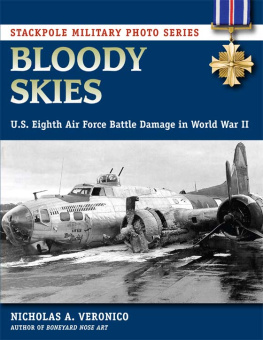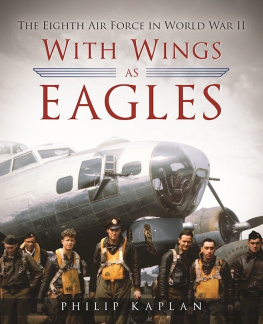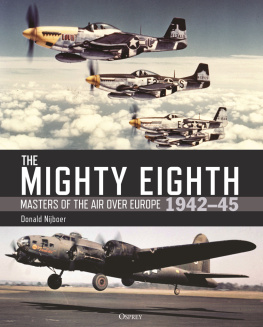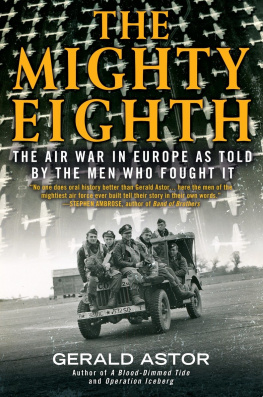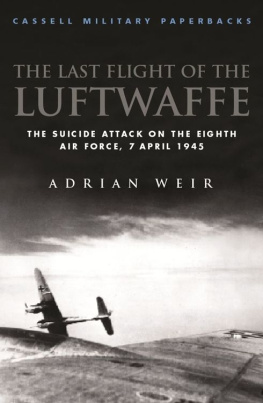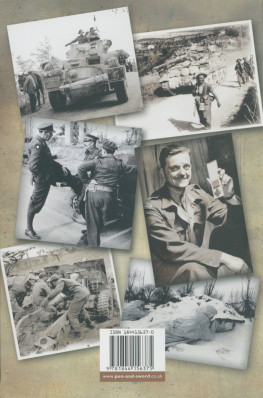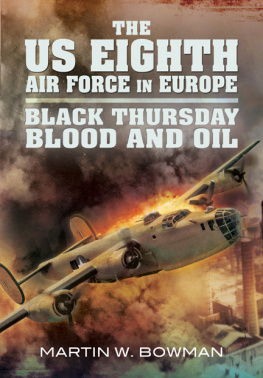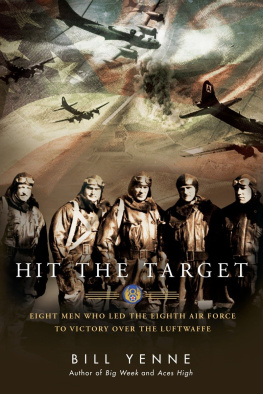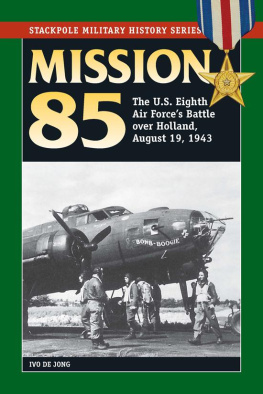Nicholas A. Veronico - Bloody Skies U.S. Eighth Air Force Battle Damage in World War II
Here you can read online Nicholas A. Veronico - Bloody Skies U.S. Eighth Air Force Battle Damage in World War II full text of the book (entire story) in english for free. Download pdf and epub, get meaning, cover and reviews about this ebook. year: 2014, publisher: Stackpole Books, genre: Non-fiction. Description of the work, (preface) as well as reviews are available. Best literature library LitArk.com created for fans of good reading and offers a wide selection of genres:
Romance novel
Science fiction
Adventure
Detective
Science
History
Home and family
Prose
Art
Politics
Computer
Non-fiction
Religion
Business
Children
Humor
Choose a favorite category and find really read worthwhile books. Enjoy immersion in the world of imagination, feel the emotions of the characters or learn something new for yourself, make an fascinating discovery.
- Book:Bloody Skies U.S. Eighth Air Force Battle Damage in World War II
- Author:
- Publisher:Stackpole Books
- Genre:
- Year:2014
- Rating:3 / 5
- Favourites:Add to favourites
- Your mark:
- 60
- 1
- 2
- 3
- 4
- 5
Bloody Skies U.S. Eighth Air Force Battle Damage in World War II: summary, description and annotation
We offer to read an annotation, description, summary or preface (depends on what the author of the book "Bloody Skies U.S. Eighth Air Force Battle Damage in World War II" wrote himself). If you haven't found the necessary information about the book — write in the comments, we will try to find it.
Bloody Skies U.S. Eighth Air Force Battle Damage in World War II — read online for free the complete book (whole text) full work
Below is the text of the book, divided by pages. System saving the place of the last page read, allows you to conveniently read the book "Bloody Skies U.S. Eighth Air Force Battle Damage in World War II" online for free, without having to search again every time where you left off. Put a bookmark, and you can go to the page where you finished reading at any time.
Font size:
Interval:
Bookmark:


Copyright 2014 by Nicholas A. Veronico
Published by
STACKPOLE BOOKS
5067 Ritter Road
Mechanicsburg, PA 17055
www.stackpolebooks.com
All rights reserved, including the right to reproduce this book or portions thereof in any form or by any means, electronic or mechanical, including recording or by any information storage and retrieval system, without permission in writing from the publisher. All inquiries should be addressed to Stackpole Books, 5067 Ritter Road, Mechanicsburg, PA 17055.
Printed in the United States of America
10 9 8 7 6 5 4 3 2 1
First edition
Cover design by Caroline Stover
Cover photo courtesy of USAAF
Library of Congress Cataloging-in-Publication
Veronico, Nick, 1961
Bloody skies : U.S. Eighth Air Force battle damage in World War II / Nicholas A. Veronico. First edition.
pages cm. (Stackpole military photo series)
Includes bibliographical references.
ISBN 978-0-8117-1455-6
eISBN 978-0-8117-6072-0
1. United States. Air Force. Air Force, 8th. 2. World War, 19391945Aerial operations, American. 3. World War, 19391945CampaignsWestern FrontPictorial works. I. Title.
D790.228th .V47 2014
940.544973dc23
2014032643
In memory of 2nd Lt. Robert L. Woolfolk and the crew of the 390th Bomb Group
B-17G Decatur Deb and those who served in the U.S. Eighth Air Force.
CONTENTS
PREFACE
T he air war in the skies over Europe during World War II was extremely complex and costly, and the Germans proved to be a formidable enemy. The Royal Air Force bombed German targets at night and the U.S. Army Air Forces took the fight to Germany during daylight hours. All of the British Commonwealth countries provided manpower to fight the Axis, and aircrews from the Soviet Union also battled the Germans.
The Army Air Forces had to fly four mission profiles in order to defeat the Germans: air superiority, ground attack/tactical bombardment, close-air support, and strategic bombing. Each mission profile dovetailed with the others. Strategic bombing of war production, petroleum, and transportation targets needed air superiority in order to succeed. Air superiority could not be achieved until the production of enemy aircraft and petroleum products was curtailed by strategic bombing. With air superiority, enemy aircraft could be destroyed on the ground before they would have the opportunity to attack the strategic bomber formations or Allied troops invading the continent. And Allied troops liberating Europe could not receive close-air support from ground attack aircraft and tactical bombers until the skies were relatively safe from marauding enemy fighters.
None of these objectives could be achieved without the might of American and Allied war production on the home front. Planes for the Allied war effort were built in Australia, Canada, England, and the United States. Americas aircraft production during World War II amounted to 295,959 aircraft, of which 200,443 were combat types. The Army Air Forces received 99,487 combat aircraft between July 1940 and August 1945. During this period, the Eighth Air Force operated B-17s and B-24s in the strategic bomber role; these were escorted first by Royal Air Force Spitfires, and later by Eighth Fighter Command P-38s, P-47s, and P-51s.
THE GREAT DEBATE
Some may say that the sacrifices of the B-17 Flying Fortress crews are greatly represented on these pages in comparison to those of the B-24 Liberator crews. While the sacrifices of all Eighth Air Force combatants are chronicled on these pages, there were two divisions (a division was typically four combat wings consisting of three bomb groups each) of B-17s versus only one of B-24s assigned to the Eighth Air Force. Thus, it can be interpreted that the pool of European Theater heavy bomber images was inherently slanted at a ratio of two B-17 photos for every B-24 picture. The total was subsequently reduced by the Army Air Forces as a result of what it chose to publish during the war and the images it chose to archive. A review of the Army Air Force/Air Force Collection images at the National Archives turns up a far greater number of B-17 photographs than those of B-24s. Its nothing personal, just the way history was recorded and preserved.
Bloody Skies: U.S. Eighth Air Force Battle Damage in World War II is a photographic chronicle of the often tragic results of aerial combat, as fought by the Mighty Eighth. This volume is intended as a tribute to those who served and those who paid the ultimate price in the air war over Europe. And let us not forget the families who suffered during the long absences when loved ones were away at war, some never to return.
Nicholas A. Veronico
San Carlos, California

Graphic presentation of how the Eighth Air Force was organized with four squadrons of twelve aircraft comprising one group, and three groups comprising a combat wing. Five wings made up an air division. See Appendices IIV for specific unit and station information. USAAF

W hen most people think about the Army Air Forces and the air war in Europe, they picture the Eighth Air Force of 1945an air force that ranged over Fortress Europe, destroying industrial and military targets at will on a daily basis. The Eighth Air Force of 1945 was triumphant; they were the victors, owners of air superiority over the nations that had once been subjugated by the armies of Adolf Hitlers Third Reich. But the Eighth Air Force of 1945 was very far removed from the dark days of December 1941 when America entered the war. The first half of 1942 was no better for America as the shock of war set in and the U.S. military was thrust from a stance of guarded neutrality into total war.
In the early months of 1942, England was absorbing the brunt of Hitlers thirst for conquest as the Nazi war machine had conquered most of Europe. Striking back at the Nazis, the British found the cost of daylight bomber raids to be extremely high. To hold down losses, the Royal Air Force elected to bomb cities and industrial targets in Germany at night.
Having occupied a number of European nations at little cost, Adolf Hitler turned the victorious Nazi war machine to the east on June 28, 1942. Summer weather enabled the German army to roll up to the gates of Stalingrad with relative ease. However, the Germans were unprepared for Russias harsh winter weather and the vicious counterattacks by Soviet troops.

The early and middle parts of 1942 were spent building an air force in England to take the fight to the Germans. The most expeditious way to get large numbers of four-engine bombers and twin-engine fighters across the Atlantic Ocean was to ferry them. Aircraft en route to England left North America at Goose Bay, Newfoundland, Canada, flew 780 miles to Greenland, then 775 miles to Keflavik, Iceland. It then traveled another 845 miles to Prestwick, Scotland, and on to bases in England. Not all planes completed the crossing, including B-17F 42-3128, which crashed near Patterson Field outside Grindavik, Iceland, on April 17, 1943. The pilot, Thomas F. Witt, went on to serve with the 306th Bomb Group and became commander of the 367th Bomb Group at Thurleigh, England. USAAF
Font size:
Interval:
Bookmark:
Similar books «Bloody Skies U.S. Eighth Air Force Battle Damage in World War II»
Look at similar books to Bloody Skies U.S. Eighth Air Force Battle Damage in World War II. We have selected literature similar in name and meaning in the hope of providing readers with more options to find new, interesting, not yet read works.
Discussion, reviews of the book Bloody Skies U.S. Eighth Air Force Battle Damage in World War II and just readers' own opinions. Leave your comments, write what you think about the work, its meaning or the main characters. Specify what exactly you liked and what you didn't like, and why you think so.

